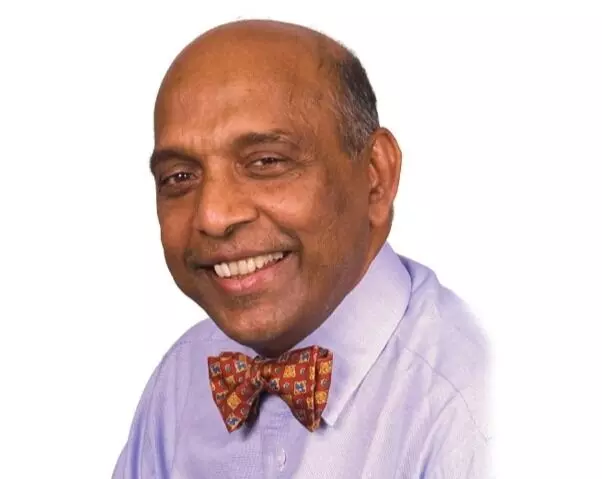Doctor speaks: How excessive use of smartphones triggers myopia among children, younger people
Most of these cases of blindness are avoidable if people have proper access to eye care, especially in remote and rural areas
By Sulogna Mehta
Hyderabad: Around 1.3 million people in India are suffering from bilateral corneal blindness. This is apart from age-related cataracts and congenital blindness, which affects crores of people.
Most of these cases of blindness are avoidable if people have proper access to eye care, especially in remote and rural areas.
Also, an increase in cases of diabetes has led to an uptick in glaucoma and diabetic retinopathy. The overuse of smartphones has caused a significant rise in myopia among children. So, eye-related issues can be hereditary (like myopia), age-related (cataract, presbiopia), and lifestyle-related (those due to diabetic retinopathy, nutrition deficiency, and subjecting the eyes to excess screen time).
Dr Gullapalli N Rao, founder-chairman of L V Prasad Eye Institute (LVPEI) spoke to News Meter about the various causes of blindness in India, the challenges in treatment, about the latest technologies and treatment modalities.
Dr Rao further said, “Glaucoma can attack people with or without diabetes and it may not have symptoms. Around 10 % of diabetics develop diabetic retinopathy. Once blindness occurs with the opacity of the cornea, the only way to restore sight is by corneal transplantation.”
Excess smartphone use leads to more Myopia cases among children
“Excessive use of smartphones has triggered myopia among children and younger people. Contrary to the earlier notion that myopia or difficulty in seeing faraway objects affects one till the mid-20s and then the rise in power is arrested, modern research states that myopic power enhancement can be lifelong. It affects studies, work, and normal life and high myopia may lead to other complications. Therefore, children should play outdoors at least for an hour daily and every 20 minutes, one should give at least 20 seconds of break to the eyes from the electronic screens. One should also avoid checking screens in darkness or low light,” stated Dr. Rao.
Access to treatment centers is still a challenge for many
Despite the availability of the latest technologies and skilled ophthalmologists, many patients still lack access to timely care, especially those living in remote areas. More service providers are also required to raise awareness among patients about referral centers and treatment options. Dr. Rao also cautioned against fake advertisements that claim to cure myopia.
“One should remember that the increased power is not completely reversible or curable but its progress can be arrested. If parents have myopia, taking proper precautions from childhood and early screening may prevent the genetic inheritance and progress of the disease,” he said.
Technological advances
Speaking about some of the latest advances in eye care, Dr. Rao said, “We have new technologies for laser surgeries, and new technical tools are now focusing on AI-assisted early screening of myopia. Stem cell transplants for retinal problems and gene therapies in eye treatment are in the experimental stage. New systems of giving drugs in the form of nanoparticles, injections, and drops are also developing.”
Oxford Congress honors Dr. Gullapalli N Rao
Dr. Rao had recently delivered the prestigious Doyne Lecture at the Oxford Ophthalmology Congress. Named in memory of Prof. Robert Doyne in 1917, this is the oldest eponymous lecture in ophthalmology. Prof Robert Doyne was the founder of Oxford Eye Hospital, the first-ever academic eye department, and he was the first Reader of Ophthalmology at Oxford. Dr. Rao is the first ophthalmologist in India to deliver this lecture in its 106-year history.
Dr. Rao gave the Doyne Lecture as part of the 106th Oxford Ophthalmological Congress, an annual meeting of UK-based and international ophthalmologists at Oxford. His lecture was titled ‘A Cornea Care System: Evolution,’ and he spoke about how LVPEI developed the cornea care unit which is one of the biggest such facilities in the world.
Dr. G N Rao: A living legend in Ophthalmology
After a successful career in the US as an academic ophthalmologist, Dr. G N Rao established the L V Prasad Eye Institute in Hyderabad in 1987. He wanted to work for his state and country. LVPEI eye health facility, a WHO collaborating Centre for Prevention of Blindness, has served over 3.68 crore people, with more than 50% entirely free of cost.
“Currently, LVPEI has three tertiary centres in Vijayawada, Visakhapatnam, and Bhubneswar apart from its Centre for Excellence in Hyderabad. It also has 22 rural hospitals and 250 primary centers for screening. Plans are on to set up three more secondary hospitals in Andhra Pradesh with a tertiary centre in the Kadapa district. Thirty more primary centers are also on the anvil,” said Dr. Rao.
Dr. Rao received his basic medical education in Guntur, AP, and completed his postgraduate residency training at Dr Rajendra Prasad Centre for Ophthalmic Sciences, All India Institute of Medical Sciences, New Delhi, after that trained in the US and also continued as faculty at the School of Medicine, University of Rochester, till 1986.
Dr. Rao is the past President of Academia Ophthalmologica Internationalis, the body of 80 of the most eminent academic ophthalmologists in the world. He has over 300 peer-reviewed research publications, has been a visiting professor in many universities in the world, and held many prominent international positions. Dr. Rao has been the recipient of several prestigious national and international awards.